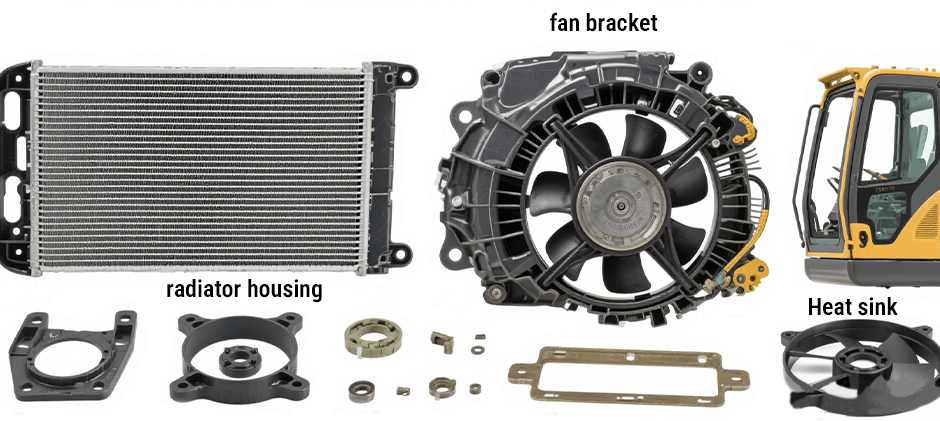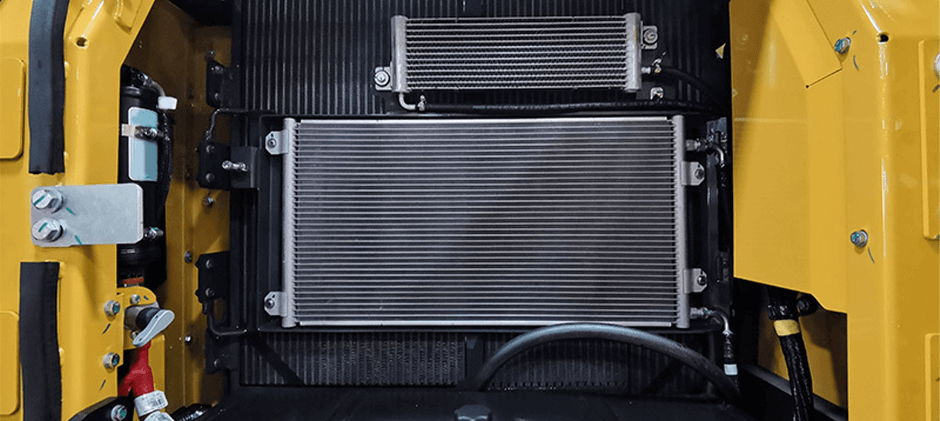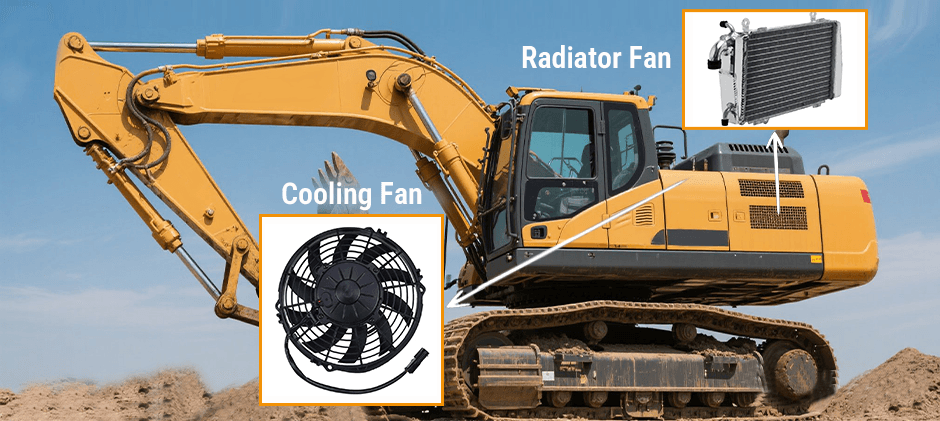When you search online for the culprit of engine overheating, you’ll find that some people say it’s the cooling fan that’s causing the problem, while others say it’s the radiator fan that’s causing the problem. So are the radiator fan and the cooling fan the same thing? I have also had such confusion; after all, both of them play a key role in cooling the engine of the equipment. However, it is very necessary for operators or maintenance workers who want to know more about their equipment to understand the difference between the two. This can help us choose the right parts to repair the equipment reasonably. This article will help you get to know their difference and functions, and share with you replacement signs as well as tips for choosing the engine fan.
What is a Cooling Fan?
A cooling fan is usually a broader term, referring to any fan responsible for cooling different parts of the equipment. Although it includes radiator fans, it can also refer to fans that cool other components. So the cooling fan and the radiator fan are mutually exclusive. In most construction machinery, such as excavators and loaders, they are the same fan is used, while in some complex equipment, such as mining trucks.
The cooling fan is usually located inside the engine, and it works by drawing air from the engine compartment to help cool the engine. It helps dissipate the heat generated by the engine. It is a mechanical fan driven by a belt connected to the engine or an electric fan that activates based on engine temperature. In some designs, it operates continuously while the engine is running.
There are two main types of engine cooling fans commonly used in heavy equipment and off-road machinery:
Mechanical Cooling Fans: These fans are belt-driven and connected directly to the engine. They run continuously whenever the engine is operating, providing steady airflow. However, mechanical fans can be less efficient at higher speeds and may slightly reduce engine power due to constant energy draw.
Electric Cooling Fans: Controlled by a thermostat, electric fans operate only when additional cooling is needed. They offer improved efficiency by adjusting fan speed based on the engine’s temperature, helping optimize fuel use and performance. Electric fans are especially beneficial in heavy-duty applications where precision cooling is required.
Without an efficient cooling fan, the engine is at serious risk of overheating, which can cause costly damage and reduce performance.
What is a Radiator Fan?
The radiator fan is also called a cooling fan in heavy machinery such as excavators and loaders, and usually can be found near the engine, such as on the front or side of the engine. In complex equipment, the blades in the radiator are the radiator fan, which usually cools the coolant passing through the radiator by drawing in cool air. As coolant that has absorbed engine heat circulates through the radiator core, this forced airflow dissipates the heat, lowering the coolant’s temperature before it returns to the engine. This process is essential for heat dissipation, especially when your machinery is stationary or moving at low speeds, where there isn’t enough natural airflow. Therefore, although the engine also has a cooling function, the radiator is also an indispensable part of the entire equipment. It usually operates independently as an electric fan outside the engine, and starts to assist in cooling the engine when the engine reaches a certain temperature.
Difference Between Radiator Fan and Cooling Fan
Through the above explanation, I believe you have a deep understanding of both. When it comes to maintaining the optimal operating temperature in heavy equipment and off-road machinery, radiator fans and engine cooling fans are one thing and play a crucial role. But in complex devices, their functions and locations may be different.
● Different locations
The radiator is usually close to the engine and around the engine to facilitate air circulation and heat dissipation, ensuring that the radiator can effectively reduce the engine temperature. The engine fan is located inside the engine. Other cooling fans are located in various locations of the equipment, depending on the device.
● Different cooling targets
The radiator fan is specifically designed to cool the engine coolant. Radiator fans are often operated independently based on engine temperature, providing additional airflow when natural airflow is insufficient, such as during low-speed operations or idle periods. Helping prevent engine overheating in critical situations. On the other hand, the cooling fan can cool various components within the equipment, though it is frequently referred to as the engine cooling fan. The engine cooling fan actively draws air through the engine compartment to lower engine temperature. Its primary role is to directly prevent the engine itself from overheating, supporting consistent engine performance.
Engine Cooling Fan vs Radiator Fan, Which Matters More?
The answer depends on perspective—both are vital. Without an efficient radiator fan, the coolant would fail to release excess heat. Without a functional engine cooling fan, the engine’s internal temperature could rapidly exceed safe limits. In fact, both components work together as part of the engine cooling system to ensure your equipment remains operational under demanding conditions.
If either fan begins to fail, your machine could suffer from overheating, leading to costly repairs and downtime. That’s why regular inspection and timely replacement of both radiator fans and engine cooling fans are essential for extending the lifespan of your heavy equipment.
Signs of Cooling Fan Replacement in Off-road Machinery
A failing fan can quickly lead to severe radiator overheating and engine damage. Watch for these warning signs:
- Engine Overheating: The most critical sign. If your temperature gauge climbs, especially at idle or low speeds, the fan is the first component to check.
- Loud or Unusual Fan Noise: Grinding or whirring sounds often point to a failing fan motor or clutch bearing. A rattling noise could be a loose or damaged fan blade.
- Visibly Damaged Fan Blades: Inspect the blades for cracks, chips, or warping. A damaged fan blade is unbalanced and inefficient, and can cause destructive vibrations.
- Fan Doesn’t Spin: If the fan doesn’t engage when the engine gets hot, you could have a failed fan motor, a bad radiator fan switch, or a seized mechanical fan clutch.
- Wobbly Fan: If the fan assembly wobbles, it indicates worn-out bearings that require immediate attention.
Regularly inspecting your equipment and replacing broken parts when necessary is one way to extend the life of your equipment. When a problem occurs with your equipment, it is more cost-effective and environmentally friendly to purchase high-quality parts to repair the equipment rather than replace the entire device. FridayPart offers aftermarket parts for most brands and a large number of equipment, making it convenient for you to purchase parts in one stop.
 How to Choose the Best Cooling Fan for Heavy Equipment
How to Choose the Best Cooling Fan for Heavy Equipment
When selecting a replacement fan, consider these factors:
Compatibility: Ensure the fan is an exact match for your machine’s make, model, and year. Check part numbers carefully.
Fan Type: Replace the fan with the same type (mechanical, electric, hydraulic) as your machine was designed for.
Build Quality: Look for durable materials that can withstand the vibration and debris of an off-road environment.
Radiator Cooling Performance: Choose a fan designed to meet or exceed the original equipment’s airflow specifications to ensure proper radiator efficiency improvement.
If you don’t know how to choose the right accessories, you can confirm by referring to your device manual or directly asking the supplier about the accessory information for your device. If you need to purchase, please pay attention to checking the other party’s real reviews to avoid a bad experience.
Conclusion
In heavy equipment, the cooling fan and radiator fan are different names for the same thing, but in more complex, multi-functional equipment, such as mining trucks or high-end multi-functional equipment, they are different fans responsible for different cooling tasks. Understanding their differences can help deal with the maintenance of different devices, saving time and repair costs. If you’ve spotted signs of failure happening to your excavator or other heavy equipment, welcome to visit FridayParts.com. We offer a vast inventory of high-quality replacement fans with wide compatibility for many heavy equipment brands. Find the right fan for your machine today and keep your engine cool under pressure.


